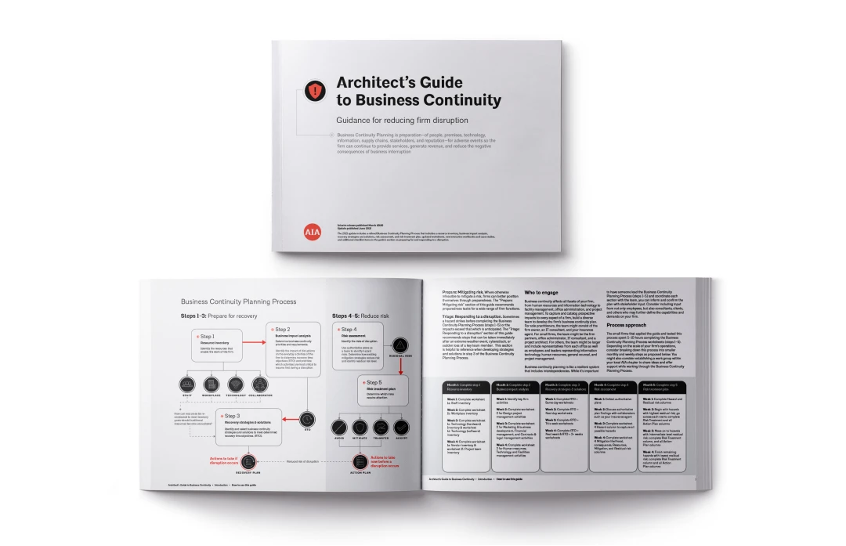Resilience Guides
The world is experiencing a period of dramatic change, resulting in climate system impacts to temperature, sea level, storms, wildfires, food production, and human conflict. Population growth, aging infrastructure, and other social and economic conditions also place strain on the built environment. This crisis underscores the need for a resilient and climate-adaptive built environment. 1
Resilient thinking is the foresight to see how changes might affect our built environment and respond and accommodate or recover from the effects of a hazardous event in a timely and efficient manner.
Our profession has the power to address resilience challenges by understanding project risks and vulnerabilities, advising clients about climate-adaptive alternatives, supporting performance goals through the design phase, implementing them in construction, and leading stakeholder engagement efforts throughout. 2
While the Co-Chair of the AIA Resilience & Adaptation Advisory Group Megan Recher helped write and collaborate on the many articles and resources including the Architects Guide to Business Continuity, the Resilient Project Process Guide and the Resilient Design Toolkit. See below for a summary and links to these documents.
Architect’s Guide to Business Continuity
Photo of the Architect’s Guide to Business Continuity, courtesy of AIA
Business Continuity Planning is preparation for adverse events so the business can continue to provide services, generate revenue, and reduce the negative consequences of business interruptions. 3
The Architect's Guide to Business Continuity helps firms become more resilient with a step-by-step process for assessing and reducing risks associated with disruption (of any kind). The guide shares lessons learned, builds on and adapts business continuity best practices specifically for the building industry, and helps firms remain open and operational during a disruption. While designed with the architect in mind, this Guide can also benefit professional service providers and clients. 3
Image from the Architect’s Business Continuity Guide, courtesy of the AIA
Business continuity can also lead to insurance discounts, a positive reputation for building performance, and even new business opportunities.
The guide can also be used for Architects to help their clients and your community to strengthen their resilience operation plans. 4
Resilient Project Process Guide
Photo of the Fundamentals of Resilient and Climate Adaptive Design, courtesy of Duany Plater-Zyberk & Company + AIA
The Resilient Project Process Guide helps outlines a design approach for integrating resilience with additional resources to streamline the design process. This is an actionable resource, organized by project phase and identifies the points in which resilience and climate adaptation goals can be turned into specific design solutions for your project. 5
This guide is a good starting point for any project team to start to get a stronger understanding of resilience, and what is expected per project phase. It is a scalable document which can be adapted to your project size, location, and phases.
Resilience Design Toolkit
Image from Resilience Design Toolkit, courtesy of AIA & HKS
The Resilience Design Toolkit was initially developed through at HKS in 2021. In 2022, the AIA Resilience & Adaptation Advisory Group (RAd-AG) developed a partnership with HKS to bring the Resilience Design Toolkit to AIA members and provide knowledge of how to integrate into design. 6
This Toolkit is another great resource to help design teams integrate resilience into their projects, understand what questions to ask whom and when and ultimately help create a more resilient future for all.
Resources
Architect’s Guide to Business Continuity
Resilience Project Process Guide
HUD Designing for Natural Hazard Series
___________
United Nations International Strategy for Disaster Reduction, UNISDR Terminology on Disaster Risk Reduction, 2009. preventionweb.net/files/7817_UNISDRTerminologyEnglish.pdf
U.S. Global Change Research Program, Glossary. globalchange.gov/climate-change/glossary
The Architects Guide to Business Continuity, June 2021
https://www.aia.org/resources/6282340-architects-guide-to-business-continuity
https://www.aia.org/resources/6512008-aia-resilience-project-process-guide
https://content.aia.org/sites/default/files/2023-05/2023_Resilience_Design_Toolkit_HKS_AIA_FINAL.pdf





